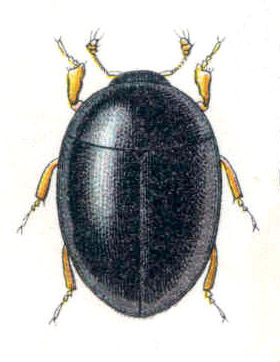Myxophaga facts for kids
Quick facts for kids Myxophaga |
|
|---|---|
 |
|
| Sphaerius acaroides | |
| Scientific classification |
|
| Kingdom: | Animalia |
| Phylum: | Arthropoda |
| Class: | Insecta |
| Order: | Coleoptera |
| Suborder: | Myxophaga Crowson, 1955 |
| Families | |
|
Hydroscaphidae |
|
Myxophaga are a special group of tiny beetles. They are a small suborder of beetles, meaning they are a distinct branch within the larger beetle family tree. There are only about 65 different species of these little insects, which is quite few compared to other beetle groups!
These beetles are usually found in or near water. They are either fully aquatic (living in water) or semi-aquatic (living partly in water and partly on land). Myxophaga beetles get their food by eating algae, which are tiny plant-like organisms often found in water.
Contents
What Makes Myxophaga Special?
Myxophaga beetles are known for being incredibly small. Many of them are less than a millimeter long, making them hard to spot without a magnifying glass! Their small size and unique watery habitats set them apart from most other beetles.
Where Do Myxophaga Live?
You can find Myxophaga beetles in various wet places around the world. They often live in freshwater environments like ponds, streams, and even damp soil next to water. Some species prefer fast-flowing water, while others like calm, still pools. Their ability to live in water is a key feature of this beetle group.
What Do Myxophaga Eat?
These tiny beetles are mostly herbivores, meaning they eat plants. Specifically, they feed on algae and other microscopic organisms that grow in their watery homes. By grazing on algae, they play a small but important role in their aquatic ecosystems.
The Four Families of Myxophaga
Even though there are only about 65 species, Myxophaga are divided into four main families. Each family has its own unique characteristics, but they all share the common traits of being small and living in or near water. The four families are:
- Hydroscaphidae
- Lepiceridae
- Sphaeriusidae
- Torridincolidae
These families show the diversity within this small suborder of beetles.
Images for kids
See also
 In Spanish: Myxophaga para niños
In Spanish: Myxophaga para niños



